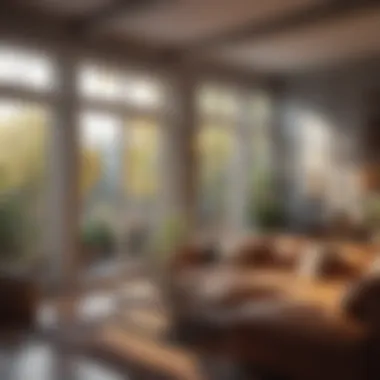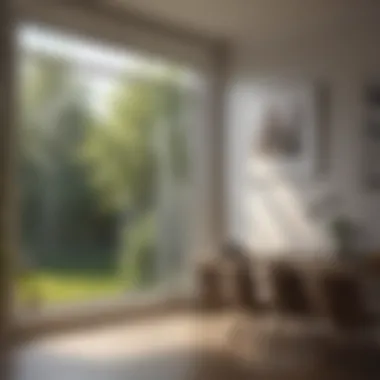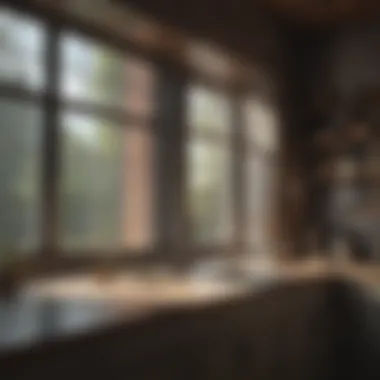Effective Strategies for Preventing Drafts from Windows


Intro
When chill winds whip through the bones of your home, it’s often the windows that are to blame. Drafts, those pesky gusts of air seeping through crevices and cracks, can transform a cozy living space into a cold confinement. Understanding and addressing this issue is not just about comfort; it’s about conserving energy and reducing bills, too. In times when the cost of living keeps rising, homeowners need to grasp the importance of preventing drafts from windows like it's second nature.
Drafts can creep in uninvited, affecting the entire household. They are particularly notorious in older homes, where the windows may have aged poorly or were not installed correctly to begin with. Identifying these challenges early can save homeowners a wealth of trouble down the line, ensuring that they preserve both warmth in winter and coolness in summer. Today, we will dive into effective methods for mitigating these drafts, making your residence not just a house, but a fortress against the elements.
Understanding the Causes of Drafts
When it comes to making a home comfortable and energy-efficient, understanding the causes of drafts is crucial. Drafts can undermine heating efforts, leading to increased energy bills and a less inviting living space. Knowing what causes these unwanted air leaks can guide homeowners toward effective solutions. Be it the design of windows, environmental factors, or simple wear from age, pinpointing why drafts occur is the first step to tackling the issue head-on.
The Role of Window Design
The design of windows plays a pivotal role in their ability to prevent drafts. Various elements such as the type of material used in frames, the installation technique, and even window styles, are all significant factors. For instance, single-pane windows lack insulation properties compared to double or triple-pane models. This kind of window not only lets drafts slip in but also allows warmth to escape seamlessly.
To counteract potential air leaks, consider investing in better window designs. Vinyl or fiberglass frames, for example, tend to seal more effectively compared to traditional wooden frames. Furthermore, the alignment and weatherproofing around window edges matter immensely; if they aren't installed precisely, drafts are almost guaranteed. Also, consider window orientation, as some directions will experience more exposure to wind or environmental conditions than others.
Impact of Environmental Factors
Weather can be an unpredictable foe. High winds, heavy rain, and fluctuating temperatures can put your windows to the test. If your region often faces harsh winters or scorching summers, the pressure placed on your windows can lead to the gradual formation of gaps or cracks. This isn’t just a minor inconvenience; it’s a recipe for higher energy expenditures.
Moreover, natural elements like humidity can exacerbate this situation. When air is humid, it can cause wood frames to swell, making them less effective at sealing out drafts. Choosing windows suited to your local climate can make a world of difference. For example, windows that feature heat-reflective coatings can keep homes cooler in summer and warmer in winter.
Effects of Wear and Tear
As with many household features, time takes its toll on windows. Over the years, wear and tear can erode the effectiveness of even the finest windows. The seals that keep windows airtight can begin to degrade, leading to gradual air leaks. Cracks in the glass or the deterioration of frames can be a slow process, but once they start, it’s not long before the drafts make themselves known.
It's wise to routinely inspect windows for signs of aging, such as cracking or warping. Addressing these issues early can prevent small problems from becoming significant headaches. Regular maintenance not only extends the lifespan of your windows but also helps mitigate potential draft issues down the line. In essence, treating your windows with the attention they deserve will reward you with a more comfortable and energy-efficient living space.
"Identifying the source of drafts is just as important as finding the solution. Understand the why before jumping into the how."
Identifying Draft Symptoms
Identifying draft symptoms serves as the foundational step in tackling the persistent annoyance of air leaks from windows. By being proactive about spotting these signs, homeowners not only enhance their comfort but also achieve substantial energy savings over time. Ignoring drafts can lead to inflated energy bills, constant fluctuations in temperature, and even damage to property. Through this section, we can acquire insight into various indicators that denote potential air leaks.
Visual Cues of Air Leaks
When it comes to spotting drafts, the eyes can be a powerful tool. Pay close attention to your windows; the gaps and spaces surrounding them can often reveal where air leaks might be lurking. Look for the following:
- Dust and dirt build-up around the edges, indicating air flow that carries particles.
- Moisture condensation on the glass, which can happen when warm, moist air meets cooler window surfaces.
- Discoloration or peeling paint around window frames, showing signs of prolonged exposure to drafts.
These visual cues are critical; they not only hint at the presence of drafts but also signal the need for deeper inspection and potential repairs. Sometimes, simply noticing these imperfections can lead you down the path of effective solutions.
Temperature Discrepancies
Another important aspect to consider is temperature differences around windows. If a room feels warmer or cooler in certain spots, especially near windows, this might mean that it is a drafty area. Here's how to assess temperature discrepancies:
- Use your hand: Feel around the window area; if it feels cooler than the room’s average, that's a tell-tale sign.
- Thermometers: Consider placing thermometers at varying locations in the room. If you find significant variances in temperature readings, it could indicate a draft problem.
- Infrared thermometer: A more high-tech option, this tool allows you to pinpoint cooler areas without direct contact.
Recognizing these temperature cues is vital for any homeowner who wants to ensure their space remains cozy and efficient throughout the seasons.
Sound Indicators of Drafts
Often, the soft whispers of drafts can go unnoticed, but taking heed of sound can be equally effective in pinpointing air leaks. Listen closely for:
- Whistling noises while the wind blows; this might be air trying to force its way through cracks.
- Rustling papers or curtains moving even when there’s no direct breeze, indicating a subtle airflow.
- Tapping or knocking sounds, which can come from wind making contact with loosely held window frames.


These auditory signals can serve as immediate alerts to homeowners, underscoring the need for further examination and swift action against the culprits behind those drafts.
Understanding these symptoms is not just about comfort—it's about creating a more energy-efficient home. When drafts are identified early, homeowners can transition to effective prevention strategies without undue delay.
Practical Solutions for Draft Prevention
Addressing drafts from windows is not merely a matter of comfort; it greatly influences the energy efficiency of a home. Effective strategies can help maintain a more stable indoor temperature, which benefits both the environment and your wallet. Understanding and employing practical solutions is paramount for homeowners aiming to minimize energy waste and enhance their living conditions. In this section, we��’ll delve into several tried-and-true methods for preventing drafts, focusing on the underlying mechanisms and benefits of each approach.
Sealing with Weatherstripping
Types of Weatherstripping Materials
When it comes to sealing drafts, weatherstripping is often the first line of defense. Essentially, there are several types of materials like foam tape, V-strip, and door sweeps that can be used effectively. Foam tape is soft and compressible, making it a suitable choice for uneven surfaces. Meanwhile, V-strip, a flexible plastic or metal material, is great for areas that require a tight seal.
The advantage of weatherstripping lies in its affordability and ease of installation, which makes it a popular optioon. For instance, foam weatherstripping has the added benefit of excellent thermal insulation properties. This means it can keep your home warm during winter and cool in the summer, providing year-round comfort. On the flip side, weatherstripping materials can wear out over time and may require periodic replacement.
Application Techniques
Applying weatherstripping correctly is vital for its effectiveness. First, ensure the surfaces are clean and dry; this allows for proper adhesion. For foam tape, simply cut it to size and firmly press it where the window meets the frame. V-strips may require more precision, as they need to be straight and aligned properly.
The notable thing about weatherstripping is the ease of DIY installation. Homeowners can often accomplish this task without the need for professional assistance, leading to cost savings. However, it’s important to note that improperly applied weatherstripping can lead to gaps, thereby negating its protective function.
Utilizing Caulking for Gaps
Choosing the Right Caulk
Caulk acts as a sealant that fills small gaps and cracks around windows, preventing drafts from entering. Choosing the right type of caulk is critical for this task. Silicone-based caulk is waterproof and flexible, making it suitable for exterior applications, while acrylic caulk is paintable and works well indoors.
A significant aspect of caulking is its longevity. Once applied, it can last for several years, which means homeowners won't have to repeatedly repurchae it. However, not all caulk is created equal; some may not adhere well to certain materials, limiting their effectiveness in some cases.
Effective Caulking Methods
For effective results, it's essential to apply caulk using a caulking gun. Begin by cutting the tip of the caulking tube at a slight angle, then hold the gun at a 45-degree angle to the gap. Applying steady pressure allows for even distribution.
One unique feature of caulking is that it can serve multiple functions, from stopping drafts to preventing moisture from seeping in. While it provides an effective barrier, it does require a little practice to apply neatly. Messy caulking joints can detract from the aesthetic appeal of your windows.
Installation of Window Film
Benefits of Window Film
Window film is an often-overlooked solution for controlling drafts. This thin layer can be applied directly to window surfaces and has a dual purpose: it aids in insulation and reduces UV light. By blocking harmful rays, it also protects furniture and carpets from fading, making it a valuable investment for homeowners.
Notably, window film is not just effective during winter. In warmer months, it can keep the interior of the house cool, which can substantially reduce air conditioning costs. On the downside, window film may not be as effective for very high-quality glass windows, where the thermal properties are already optimized.
Step-by-Step Installation Process
The installation of window film involves several straightforward steps. Clean the window thoroughly to ensure that there are no dust or grease particles that might affect adhesion. Cut the film to size, allowing a bit of overlap for easier application. Spray a light mist of water on the window before placing the film, which allows for adjustments during positioning.
Once in place, squeegee out the water to eliminate bubbles. This method is highly beneficial as it’s generally a one-time, straightforward task that yields substantial long-term benefits. While it may require some time to get the process right, the energy savings over the years can be worth the initial investment of effort.
Upgrading Window Insulation
Types of Insulated Windows
Upgrading your windows can represent a significant improvement in minimizing drafts. Insulated windows come in various types, including double-pane and triple-pane windows, which are designed specifically for thermal efficiency. The spaces between the panes are often filled with argon gas, providing additional insulation.


The key characteristic of these windows is their ability to significantly reduce energy loss. However, they can require a larger upfront investment compared to simpler glazing options, but homeowners often find the long-term savings on energy bills worthwhile.
Cost-Effectiveness of Insulation
The price associated with upgrading windows can vary greatly, which is a factor that needs careful consideration. Though the initial cost might be high, the return on investment often becomes apparent through reduced energy expenses over time.
Additionally, newer insulated windows often add value to a home when it comes time to sell, making them an attractive option for homeowners looking to increase their property's value. However, while insulated windows can be more expensive, homeowners should look at them as a long-term investment rather than a short-term expense.
Innovative Technologies in Draft Prevention
In the realm of home comfort, the advancement of technology plays a pivotal role in keeping our living spaces cozy and energy-efficient. Innovative technologies have emerged as game changers in preventing drafts from windows, providing homeowners with cutting-edge solutions that not only tackle the issues but also enhance the overall home experience. By incorporating smart designs and modern materials, these technologies can significantly transform how we manage air flow and temperature in our homes.
Smart Window Systems
Features of Smart Windows
Smart windows are a crucial innovation in draft prevention, equipped with features that adjust depending on the external environment. These windows often incorporate electrochromic or thermochromic technologies, which allow them to tint automatically in response to sunlight or temperature changes. This adaptability not only serves to block out excessive heat or cold but also to create a uniform indoor climate year-round.
One key characteristic of smart windows is their ability to communicate with home automation systems. This means they can work in concert with heating and cooling systems or even smart thermostats, optimizing energy use throughout the day. Such integration presents a significant advantage over traditional options, as it helps to maintain an even temperature inside the home and reduces the reliance on mechanical heating.
A unique feature worth noting is the self-cleaning property that some smart windows offer. By repelling dirt and grime, these windows minimize maintenance tasks and ensure a clearer view and greater light penetration. However, the initial investment for such advanced technology can be higher than standard double-glazing. Understanding both the long-term benefits and upfront costs is crucial in deciding whether smart windows are the right choice.
Energy Efficiency Benefits
The energy efficiency benefits of utilizing smart window systems are hard to overlook. When these windows are properly installed, they contribute to a substantial reduction in heating and cooling costs. Their ability to reflect sunlight during hot weather or retain warmth during colder months can support a balanced energy usage strategy.
One aspect that enhances the appeal of energy efficiency in smart window systems is their contribution to reducing carbon footprints. As homeowners become more aware of environmental impact, smart windows represent a proactive choice in sustainable living. This shift is becoming increasingly popular among those seeking to not only enhance their comfort at home but also to contribute positively to the planet.
Moreover, these windows can control the amount of UV rays entering the home, which helps in protecting furniture and flooring from fading over time. Still, it's worth bearing in mind that this technology may require some form of a backup plan during electrical outages, raising concerns for those in areas with unreliable power networks.
The Potential of Air Curtains
How Air Curtains Function
Air curtains are another innovative solution in preventing drafts, working on a principle that's straightforward yet effective. By creating a barrier of air across doorways or window openings, they act as a buffer against environmental conditions. This technology functions by drawing air from the surrounding area and blowing it out through a narrow opening, effectively shielding the interior from outside elements.
One key aspect of air curtains is their versatility. They can be utilized in both residential and commercial settings, enhancing energy efficiency across a broader range of applications. This makes them a useful consideration for homeowners who might often entertain guests or have high traffic areas in their homes. The capability to maintain a comfortable indoor environment while allowing free movement can prove invaluable.
A unique feature of air curtains is their ability to work independently of traditional ventilation systems. This independence often results in reduced energy consumption and can contribute positively to overall energy bills. However, proper placement is critical to maximize their effectiveness and ensure that the airflow is sufficient to create a proper barrier.
Applications in Residential Spaces
In residential settings, air curtains offer a practical solution for doorways leading to outdoor spaces, garages, or even between rooms in larger homes. Their capability to minimize drafts makes them especially valuable in homes with large entryways where energy loss can be substantial.
The significant advantage of air curtains is the enhanced comfort they provide without needing to compromise on aesthetics or space. Many modern designs are sleek and unobtrusive, integrating seamlessly with the home’s decor. Still, homeowners must consider the noise level associated with some units, as certain designs may produce noticeable sound when in operation.
Additionally, the potential for energy savings, along with their ease of installation, makes air curtains a popular choice among homeowners looking to improve indoor air quality while also enhancing comfort. Yet, attention should be given to choosing an appropriately sized unit for the specific application to ensure optimal results.
Long-term Maintenance Strategies
Establishing a long-term maintenance strategy for windows is crucial for sustaining comfort and energy efficiency in your home. Drafts not only detract from your living experience, but they can also lead to increased energy costs over time. When windows are not properly maintained, they are likely to fall into disrepair, allowing outside air to seep in, and, ultimately, skewing your heating and cooling systems. A proactive approach to window maintenance can yield significant savings and security.
Benefits of Long-term Maintenance
- Energy Savings: A consistent inspection schedule can identify potential issues before they escalate, saving you money on energy bills.
- Increased Comfort: Well-maintained windows help in regulating indoor temperatures, keeping your living space comfortable regardless of the weather.
- Prolonged Lifespan: Regular care can extend the life of your windows, ensuring they function optimally for years.
- Home Value: Keeping windows in top shape can enhance your property value, making it more appealing to potential buyers.


Considerations
It's essential to develop a routine that fits your life and incorporates seasonal checks. For instance, inspecting in the spring can prepare your home for summer heat while fall checks can set you up nicely for winter months.
"An ounce of prevention is worth a pound of cure." Taking the time to maintain your windows can prevent costly repairs down the road.
Regular Inspection Routines
Creating a regular inspection routine is your ace in the hole for catching issues before they turn into larger problems. Even if your windows seem fine at a glance, small issues can lead to bigger headaches if they’re left unchecked. Here’s how to set up an effective inspection plan:
- Monthly Visual Inspections: Look for signs of decay, such as peeling paint or mold. Take notes.
- Quarterly Functional Tests: Open and close all windows to ensure they operate smoothly. Listen for any unusual sounds, indicating problems with the hinges or seals.
- Bi-annual Professional Checks: If you feel uncertain about DIY inspections, consider hiring professionals who can offer a more detailed analysis.
By following these steps, you’ll not only catch small issues early but also keep your mind at ease knowing you've taken preventive measures.
Seasonal Maintenance Tips
Seasonal maintenance is crucial because the conditions can change drastically, impacting how your windows perform. Here’s a breakdown of tasks to tackle each season, ensuring your windows remain draft-free year-round:
Spring
- Clean Window Frames and Sills: Remove dirt and debris that may have accumulated over the winter. This prevents grime from affecting seals.
- Inspect Weatherstripping: Check if it’s pliable. If it's cracked or hardened, it’s time to replace it.
Summer
- Apply Window Film: Protect against UV rays and reduce heat buildup. This contributes to lower air conditioning costs.
- Check for Moisture: Inspect for any signs of condensation, which can indicate issues with seals.
Fall
- Check Insulation: Prior to colder months, look at the insulation around your windows. Any gaps should be caulked or filled promptly.
- Store Screens: If you use screens, store them properly to prevent damage and ensure they are clear for use in warmer months.
Winter
- Cover Drafty Windows: Use thermal curtains to assist in insulation during the colder months.
- Inspect for Ice Damage: Look for ice formation around the frame. This can indicate potential problems with insulation.
Implementing these seasonal tasks can safeguard your home input with a solid defense against drafts, while keeping your space cozy and energy-efficient. By committing to regular inspections and seasonal upkeep, you're not just maintaining windows; you're investing in your home’s long-term health.
Summary and Recommendations
In the realm of home comfort and energy efficiency, addressing window drafts has emerged as a key concern for many homeowners. This section wraps up the discussion by not just reiterating the various strategies outlined in previous sections, but also underscoring their significance and providing a clear path forward.
Importance of Summary and Recommendations
Drafts can transform a cozy home into an uncomfortable environment, making it vital to take a proactive approach. A well-sealed window not only enhances comfort but also contributes to energy savings. Savings on utility bills can be a significant benefit, especially during extreme weather conditions. Homeowners, particularly, benefit greatly from investing time into understanding and mitigating drafts.
When you consolidate the solutions mentioned in the article, like weatherstripping, caulking, or opting for newer window technologies, you begin to realize that addressing drafts is not just about immediate relief. It goes beyond just comfort. Addressing these issues ensures better longevity for your windows and overall structural integrity of your home.
Properly managing drafts is essential for creating a comfortable living space and reducing energy consumption.
Consolidating Solutions
To simplify your approach to tackling drafts, consider these consolidated strategies:
- Assess Your Current Situation: Begin with a thorough inspection of your windows. Identify areas where drafts are likely entering.
- Choose Appropriate Sealing Methods: Depending on the outcome of your inspection, select from weatherstripping, caulking, or window films based on specific needs.
- Implement Up-to-Date Technologies: If you’re thinking about future improvements, smart window systems or air curtains offer modern solutions that could save money in the long run.
- Establish Regular Maintenance Routines: Regular check-ups as outlined in earlier sections are key to preventing future drafts. Lack of maintenance can lead to compounded issues that are more costly to address later.
Future Considerations
As we look to the future, it is essential to remain aware of developing trends and innovations in draft prevention. This can be particularly important in the context of sustainability, energy efficiency, as well as comfort.
- Stay Informed: Keep an ear to the ground for new technologies and techniques in window insulation and sealing. This will not only enhance your home’s comfort but also make it more appealing if you ever decide to sell.
- Adapt to Changing Climates: Climate change is unpredictable; therefore, having flexible solutions that can adapt to varying conditions is prudent.
- Potential Upgrades: Consider the long-term benefits of upgrading to more energy-efficient windows whenever feasible. Though upfront costs can be higher, the payoffs in energy savings and property value can be worth the investment.
Combining these insights into an actionable plan allows homeowners to not only take charge of their comfort but also contribute positively to the environment through better energy practices.







